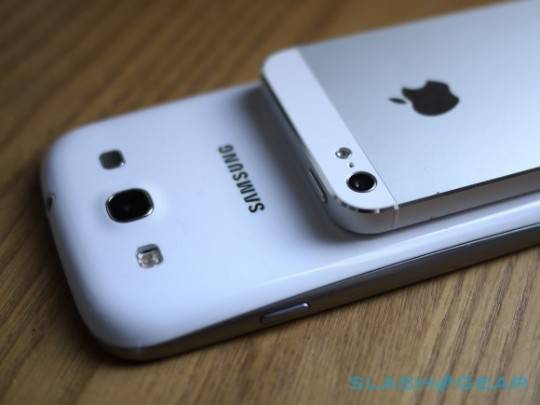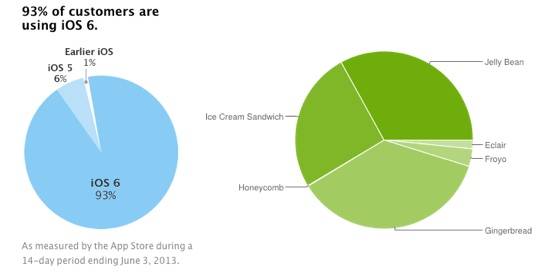
We suspect many Android fans are familiar with the pie chart that Google uses to show the break down of versions, however it looks like Apple has recently begun doing the same for iOS. While there is likely a better reason, this almost seems like Apple has done this in an attempt to bring some fragmentation shame to Google.
That said, Apple discussed these numbers back during WWDC and at first glance, the iOS pie chart does look a bit cleaner. Of course, as Android users will likely know, there is a big difference in how Android and iOS updates are handled. And honestly speaking, Apple has a good thing going with how they control the updates.
Basically, Apple controls the updates which means they are easily able to push them to devices using iTunes or an over-the-update process. Android on the other hand has the manufacturers and carriers to contend with in terms of rolling out updates. Not to mention, there are quite a few additional Android models as compared to iOS devices.

Another part of the issue are the Android devices that manufacturers and carriers are still selling. Without naming specific offenders, there are plenty of handsets still available for sale with versions that are now several years old at this point in time. With Apple on the other hand, all the devices currently being sold are running the latest version of iOS.
Bottom line here, while this seems like Apple was trying to shame Google, it does bring the topic of updates to the forefront once again. And with that, it remains that there needs to be a better system in place for pushing out these updates. Or at the very least, Google needs to find a way to ensure manufacturers and carriers stop selling outdated devices.
VIA: Apple Insider
SOURCE: iOS Dev Center, Google Developers










This must be why Key Lime Pie is supposedly supposed to run on lower specced hardware. Republic Wireless for instance is still running a modified Gingerbread build.
They need a Jelly Bean phone.
I don’t see why they would use Gingerbread anymore… It’s like two years old and JB runs just fine on lower-specced hardware (Yes, it could use some optimizations, but it wouldn’t be too difficult). In addition to that, there are quite a few apps that are 4.0+ only now, so there shouldn’t be a reason for GB to be used.
Amen, I still don’t understand and while I loved the price per month I couldn’t live on Gingerbread. I’m worried they just aren’t focusing enough engineering effort to hit 4.0+ although yes they should just jump to Jelly Bean.
I’m thinking key lime pie will baa able to use lower specs because there really shouldn’t be a need for so much power to run these small apps, plus many benefits that comes with being a more resourceful os ….
And don’t forget, though the newer iOS can run on older iPhones, MANY of the features are gimped or not available.
And Android with all it’s so called fragmentation still works better than the iPhone with its gimp feature and iFruity’s obsessive compulsive limitation of user customisation.
This is part of the reason I went to iPhone. I was stuck on FROYO for a year, and I didn’t want to get inho the same situation again. iOS is a more reliable experience with no force close issues. Also it works better with my MacBook Pro.
Thats pathetic of you. Buy an Android phone that gets instant updates. You have a little phone now with a ton of icons splashed all over your screen with no customization. Have fun in the walled garden of hell
I really don’t feel like I’m in “hell”. My phone works fine and has a lot of useful features. Having had both Android and iPhone, I see differences, of course, but it is a matter of personal preference and what works for a given individual. I don’t see one as inherently better than the other.
That’s because Android is playing a different game than iOS. Google offers the OS to any OEM and that has resulted in a massive number of different devices aimed at everyone from budget users to businessmen to tech geeks. Budget users probably don’t upgrade their phones very often, which would explain some of the stats.
Having a single phone that primarily targets a relatively affluent audience (no budget version of the iPhone) makes it a lot easier to update quickly and consistently. Apple would be in the same boat as Android is if they licensed out the OS and had a dozen OEMs pumping out dozens of phone models each year aimed at all segments of the market.
To control OS version, Google would have to take a lot more control over the hardware, enforcing minimum specs and hardware guidelines so that they could release updates directly to the phones without OEMs and carriers having to adapt AOSP to their phones. They would also have to do away with OEM skins/customizations and carrier bloatware. While many would like to see that, particularly the bloatware, that might not be the best way to rapidly increase the number of Android devices in people’s hands – which is Google’s entire goal (they only profit off of ads and apps that are seen and downloaded by users, higher profits per phone don’t help them).
Changes that would result in faster updates would also likely result in a lower market share for Android and fewer budget options.
I have a friend who has an iPhone 4. I was helping him with an issue, and swiped down on his screen to check a notification. Nothing happened. Then I noticed his map icon looked like Google Maps. I checked his version, and he was still on iOS 4. I stared at him in complete disbelief, and he stared back wondering why I was so surprised.
This was 6 months ago. He’s still on iOS 4.